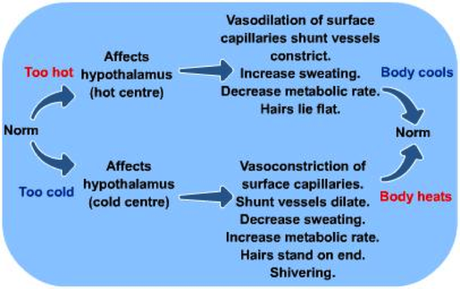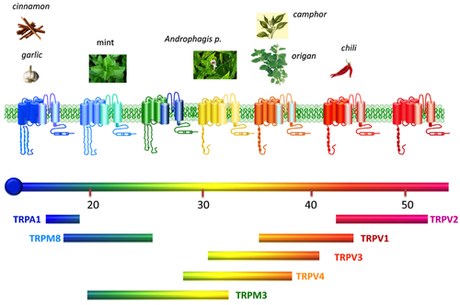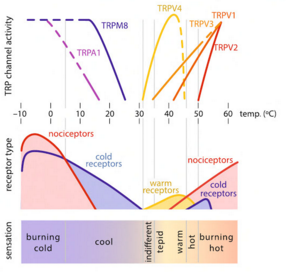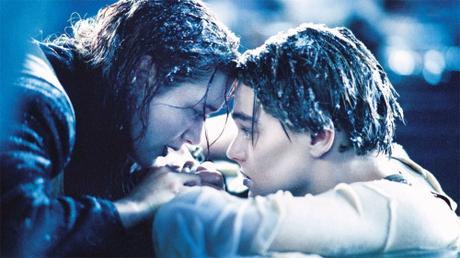 Modified from Mahmoud Ibrahim
Modified from Mahmoud Ibrahim
I wake up drenched in sweat and shivering. I feel so cold, that I pull the blankets up over my face, but when my hand touches my face it feels burning hot.
What’s going on? Is this all a fever dream? I have a fever and I’m over-heating, so the blazing skin and soaking sweat make sense, but why am I simultaneously shivering and clutching for the covers?
In honor of last weekend, which I spent unable to think of anything other than my fever, I’ll explain how temperature sensation works and four situations when your brain lies to you, and the sensation of temperature you feel is opposite of what you would expect: why chili peppers actually make you cold, how eating the wrong fish can make cold feel hot for months, and why people freezing to death strip their clothes off. (It’s also a good reminder to get your flu shot or else you might find your whole week shot, lying in your own sweat and barely able to get out of bed.)
Fever Genes
Bacteria and viruses don’t cause fevers directly, but rather it’s the immune system’s response to those microbes and then the interaction between the immune system and brain that causes a fever. In response to certain infections, the immune system releases signaling molecules called pyrogens into the blood, which are read by the hypothalamus, a brain area, which you can think of as your body’s thermostat[1]. These signaling molecules essentially turning up the temperature on the thermostat from 37°C (98.6 °F)[2] to a higher temperature, and this higher temperature may help fight off bacteria and viruses.
In a normal healthy state if your body tries to maintain a homeostasis and keep your temperature at 37°C. If your temperature drops below 37°C, your hypothalamus senses this and initiates compensatory actions to raise the temperature, such as shivering, constricting vessels near the surface of the skin (so heat doesn’t escape), making your hair stand up (AKA goosebumps if you’re a normal person, AKA piloerection if you’re a scientist). Various heating and cooling responses are illustrated in this diagram:
 From www.s-cool.co.uk
From www.s-cool.co.uk

However, in the case of the fever, when your body is at the normal 37C, the hypothalamus’s thermostat temperature has been raised, so it now thinks 37C is too cold and it will initiate the previously mentioned responses to raise the temperature such as: shivering, vasoconstriction, piloerection, and additionally cause a subjective feeling of cold which encourages behavioral responses to raise your temperature such as burying yourself under the blankets.
Okay so that explains why you can feel cold during a fever, but wait, why can fevers also cause sweating, which cools the body, and is the exact opposite of responses like shivering? Sweating actually occurs in intermittent fevers, where the fever is “breaking” and the thermostat returns back to normal. In intermittent fevers the immune system stops releasing the temperature-raising pyrogens into the blood, causing the hypothalamus’s thermostat to drop back down to 37°C, but the elevated body temperature lags behind, so now the hypothalamus is saying, “I’m too hot!” and initiates actions like sweating.
Interestingly, pyrogens and related signaling seem to have a variety of effects in the brain beyond raising the thermostat, inducing “sickness behavior,” and encouraging social withdrawal, fatigue, loss of appetite, and increased slow-wave sleep. Some have even gone so far as to argue that depression shares many similarities to this “sickness behavior” state, and this could explain some of the links seen between chronic inflammation, chronic illness, and depression. To read more about this hypothesis you can read the review by Dantzer et al. 2008, From inflammation to sickness and depression: when the immune system subjugates the brain.
Does Spicy Spicy Food Feel Hot? Does it Raise our Body Temperature?
Spicy food may feel hot, but it actually lowers body temperature. To understand why we’ll have to look at the body and how nerves sense temperature and relay this information to the brain. If you stop and think about it, the fact that the body can sense temperature is remarkable. From a physics standpoint temperature is the average kinetic energy of molecules, basically how fast are molecules spinning and bouncing around. Evolution has crafted proteins that are highly sensitive to their own speed and the speed of molecules around them, that become activated at certain temperatures and then activate neurons. These hot and cold sensitive proteins are known as the thermosensitive TRP receptors.
Neurons that express thermosensitive TRP receptors, act as temperature sensors, and then signal this information to the brain, where the information from different kinds of receptors is combined to calculate a very accurate representation of temperature in the hypothalamus. The hypothalamus then in turn uses this information to regulate body temperature as discussed above. However these TRP receptors aren’t perfect; they can be fooled, for example by chemicals such as the molecule capsaicin which makes food spicy.

Different thermo-sensitive TRP channels are activated at different temperatures. They are also activated by different compounds found in foods we commonly use as spices and flavorings. From: http://www.mdpi.com/
Hot peppers contain the molecule capsaicin, which binds to activates the TRPV1 receptor which is located on pain and temperature-sensing neurons. These neurons are normally activated temperatures greater than 42-43°C degrees, which is normally the point at which sensations go from feeling pleasantly warm to painfully hot. So, spicy foods activate these pain and temperature sensing neurons and that explains why eating spicy food can feel painful and hot, but why does it lower body temperature.

Hypothetical activation of TRP receptors at different temperatures, and correspond activity of thermo-sensitive neurons, and corresponding sensation experienced by a human. From: Neurosciences – From Molecule to Behavior: a university textbook
Lets go back again to the thermostat in our hypothalamus. The temperature-sensing neurons that are activated by the capsaicin in spicy food signal to the hypothalamus that the body is greater than 37°C. Thinking the body is hotter than it really is hypothalamus then compensates and lowers the body temperature[3].
The dose needed to evoke a 1°C drop in temperature are pretty large, 0.1–0.2 mg/kg in rats. With a jalapeño weighing 20g and having a concentration of .3% capsaicin by mass, we get around 60mg/pepper. With an average human weight of 80.7kg and the dangerous assumption our physiology is similar to rats, that means we only need the capsaicin from 1.3 to 2.6 jalapeños extracted and injected under the skin to induce a temperature decrease of 1°C. (Someone check my math.)
Most have experienced a fever and the spicy burn of a pepper, but rarer situations can affect our temperature sensation as well:
Bad Fish – Ciguatera Poisoning and Temperature Reversal
 From Voets, 2012
From Voets, 2012

During red tides, or algae blooms, reef fish and shellfish can accumulate significant levels of ciguatoxins, that when humans eat them they suffer from ciguatera poisoning, which causes a variety of symptoms including nausea, vomiting, diarrhea, headaches, body tingling, hallucinations, motor problems, and in severe causes cold allodynia, where contact with cold objects causes a burning pain. According to Thomas Voets, in his 2012 EMBO journal review, ciguatera can also cause temperature reversal “sufferers have reported that a refreshing dive in the ocean actually caused burning pain, or that drinking cool beer felt like too hot coffee.” Some patients also experience cold as extreme cold, in an interview I found on youtube an ex-sufferer described grabbing a soda as feeling like grabbing a block of ice:
A patient, later in the video at 6:09 also describes the experience temperature reversal.
The ciguatoxin P-CTX-1 makes animals experience pain at cold temperatures that normally would not elicit pain. It seems to act by increases the activation of voltage-gate sodium channels, which increases the firing of TRPA1 expressing cold-sensing neurons (these are the same neurons targeted by menthol). P-CTX-1 does not appear to be directly acting on the TRPA1 receptor itself, but rather the cold-sensitive neurons that express TRPA1 appear to be particularly sensitive to P-CTX-1. Interestingly, TRPA1 neurons have recently been indicated in itch sensation, and extreme itchiness is also a symptom of ciguatera. From the current molecular model it’s still unclear to me why ciguatera would cause temperature reversal.
Be careful eating seafood after a hurricane or red bloom, especially large fish in which toxins can bioaccumulate. Unfortunately if you get ciguatera it cannot be treated, and symptoms can last for months.
Paradoxical undressing

Unfortunately for viewers, Titanic did not feature paradoxical undressing.
Finally, a temperature reversal is suspected to take place in hypothermia. According to wikipedia, 20-50% of hypothermia deaths are associated with paradoxical undressing, where freezing people will shed their clothes. This has led forensic scientists to speculate that these people may experience a stage of freezing which feels like a burning sensation and causes the patient to shed the clothes. According to a 2010 review, a lot of mystery remains to hypothermia and paradoxical undressing, especially as to the mechanism by which freezing would cause victims to feel hot. Some have suggested that the hypothalamus may malfunction, or a peripheral mechanism may be at play. Other non-temperature regulated mechanisms may also be involved as patients also suffer from confusion and exhibit “terminal burrowing behavior,” where people have died from hypothermia are often found underneath bushes or pieces of furniture, and one can imagine that paradoxical undressing may be part of this same bizarre behavioral response. Knowledge about paradoxical undressing is important for crime scene investigators as those unfamiliar with the behavior to suspect sexual assault in cases of hypothermic death.
Conclusions
Like other sensations, temperature sensation is not always simple. Your body can intentionally lie to you in the case of fever, feeding you incorrect information that helps modify your behavior in an evolutionarily adaptive way. In the other examples, molecules and extreme situations modify the temperature sensation system causing it to malfunction.
I hope you enjoyed this article, if you did please help share!
Footnotes/Asides:
[1] Thinking about temperature regulation, the hypothalamus is almost literally a thermostat, because it is regulating temperature, but the different parts of the hypothalamus are involved in many homeostatic processes, like hunger and thirst. The hypothalamus however is an ancient and complex area, with many functions: https://en.wikipedia.org/wiki/Hypothalamus
[2] As an American I always thought there was something really important about that number 98.6°F, now I realize that they rounded it to a whole number in Celsius 37°C and then we got stuck with a weird decimal to stay consistent. Similarly, a fever is defined as the magical 100.4°F which is really just the convenient and arbitrary 38°C.
[3] Spicy foods are often more popular in hot climates than cold climates, and some have speculated that this might be explained by the fact that spicy food lowers body temperature.
Also, interestingly the opposite isn’t true for menthol. While menthol feels cold and activates a different TRP receptor on cold-sensing neurons, experiments have shown that menthol doesn’t have temperature-raising effects on the body. A good illustration that the body doesn’t always follow simple logic and these kinds of effects have to be tested experimentally.

